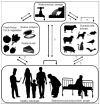Noroviruses-The State of the Art, Nearly Fifty Years after Their Initial Discovery
- PMID: 34452406
- PMCID: PMC8402810
- DOI: 10.3390/v13081541
Noroviruses-The State of the Art, Nearly Fifty Years after Their Initial Discovery
Abstract
Human noroviruses are recognised as the major global cause of viral gastroenteritis. Here, we provide an overview of notable advances in norovirus research and provide a short recap of the novel model systems to which much of the recent progress is owed. Significant advances include an updated classification system, the description of alternative virus-like protein morphologies and capsid dynamics, and the further elucidation of the functions and roles of various viral proteins. Important milestones include new insights into cell tropism, host and microbial attachment factors and receptors, interactions with the cellular translational apparatus, and viral egress from cells. Noroviruses have been detected in previously unrecognised hosts and detection itself is facilitated by improved analytical techniques. New potential transmission routes and/or viral reservoirs have been proposed. Recent in vivo and in vitro findings have added to the understanding of host immunity in response to norovirus infection, and vaccine development has progressed to preclinical and even clinical trial testing. Ongoing development of therapeutics includes promising direct-acting small molecules and host-factor drugs.
Keywords: clinic; detection; epidemiology; evolution; genome; immunity; model systems; norovirus; phylogeny; replication; treatment and prophylaxis; virion.
Conflict of interest statement
The authors declare no conflict of interest. The funders had no role in the design of the study; in the collection, analyses, or interpretation of data; in the writing of the manuscript, or in the decision to publish the results.
Figures




Similar articles
-
Human norovirus transmission and evolution in a changing world.Nat Rev Microbiol. 2016 Jul;14(7):421-33. doi: 10.1038/nrmicro.2016.48. Epub 2016 May 23. Nat Rev Microbiol. 2016. PMID: 27211790 Review.
-
[Norovirus infections: an overview].Med Sci (Paris). 2010 Jan;26(1):73-8. doi: 10.1051/medsci/201026173. Med Sci (Paris). 2010. PMID: 20132778 Review. French.
-
Noroviruses: epidemiology, immunity and prospects for prevention.Future Microbiol. 2015;10(1):53-67. doi: 10.2217/fmb.14.102. Future Microbiol. 2015. PMID: 25598337 Review.
-
Understanding the relationship between norovirus diversity and immunity.Gut Microbes. 2021 Jan-Dec;13(1):1-13. doi: 10.1080/19490976.2021.1900994. Gut Microbes. 2021. PMID: 33783322 Free PMC article. Review.
-
Norovirus: targets and tools in antiviral drug discovery.Biochem Pharmacol. 2014 Sep 1;91(1):1-11. doi: 10.1016/j.bcp.2014.05.021. Epub 2014 Jun 2. Biochem Pharmacol. 2014. PMID: 24893351 Free PMC article. Review.
Cited by
-
Mapping human norovirus antigens during infection reveals the breadth of the humoral immune response.NPJ Vaccines. 2023 Jun 6;8(1):87. doi: 10.1038/s41541-023-00683-1. NPJ Vaccines. 2023. PMID: 37280322 Free PMC article.
-
Of masks and methylene blue-The use of methylene blue photochemical treatment to decontaminate surgical masks contaminated with a tenacious small nonenveloped norovirus.Am J Infect Control. 2022 Aug;50(8):871-877. doi: 10.1016/j.ajic.2022.01.024. Am J Infect Control. 2022. PMID: 35908825 Free PMC article.
-
Selective Polyprotein Processing Determines Norovirus Sensitivity to Trim7.J Virol. 2022 Sep 14;96(17):e0070722. doi: 10.1128/jvi.00707-22. Epub 2022 Aug 16. J Virol. 2022. PMID: 35972292 Free PMC article.
-
Activation of Nod2 signaling upon norovirus infection enhances antiviral immunity and susceptibility to colitis.Gut Microbes. 2023 Dec;15(2):2249960. doi: 10.1080/19490976.2023.2249960. Gut Microbes. 2023. PMID: 37655966 Free PMC article.
-
In Vitro Antiviral and Virucidal Activity of Ozone against Feline Calicivirus.Animals (Basel). 2024 Feb 22;14(5):682. doi: 10.3390/ani14050682. Animals (Basel). 2024. PMID: 38473067 Free PMC article.
References
Publication types
MeSH terms
Substances
LinkOut - more resources
Full Text Sources
Medical

